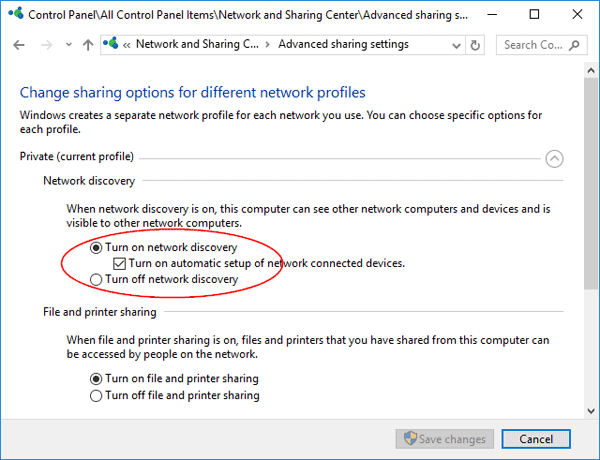Network discovery is a valuable feature in Windows 10 that allows your computer or device to find and connect with other devices on your network. It is particularly useful when you want to share files, folders, and printers with other computers and devices in your home or workplace. In this guide, we will walk you through the process of enabling network discovery and configuring sharing options in Windows 10.
Network discovery is a built-in feature in Windows 10 that allows your computer to automatically detect and connect with other devices on your network. It is especially useful when you want to access shared folders, files, and printers on other computers or devices. By enabling network discovery, you can easily find and connect with other devices within your home or workplace network.
It’s important to note that network discovery is automatically turned on when you are connected to private networks, such as your home or office network. However, it is turned off when you are connected to public networks to ensure the security of your device. Additionally, you can choose whether to allow your PC to be discoverable on those networks or not.
Enabling Network Discovery
If your Windows 10 computer or device is unable to view other computers on the network, it’s likely that either the incorrect network profile (public instead of private) is assigned or network discovery is turned off. Here’s how you can activate network discovery in Windows 10 for your active network profile:
Step 1: Open Settings
- Click on the Start button in the bottom left corner of your screen.
- Select the Settings gear icon from the Start menu.
Step 2: Click Network & Internet
- In the Settings window, click on Network & Internet.
Step 3: Select Your Network Connection
- In the left panel of the Network & Internet settings, click on either Wi-Fi (if you’re connected to a wireless network) or Ethernet (if you’re connected to a network using a network cable).
Step 4: Access Advanced Sharing Settings
- A window with settings for your network will appear. Find the Related setting section on the right side of the window and click on Change Advanced Sharing Settings.
Step 5: Turn on Network Discovery
- In the Advanced Sharing Settings window, expand the network profile currently assigned to your network connection. It is marked with the words “current profile” on the right side of its name.
- Within the Network discovery section, select the option to Turn on network discovery. Also, check the box that says Turn on automatic setup of network connected devices.
Step 6: Save Changes
- Click on the Save Changes button to apply the changes you made.
Step 7: Close the Settings Window
- Finally, close the Settings window.
You have successfully enabled network discovery in Windows 10 for your active network profile. It’s important to note that you should never enable network discovery when connected to public networks. If you’re connected to a public network, such as those found in airports or cafes, make sure to set the network profile to Public.
Enabling File and Printer Sharing
When connected to private networks, Windows 10 automatically turns on the File and Printer Sharing setting. This allows you to easily share folders, files, and printers with other computers and devices on your network. However, if this setting has been adjusted by your network administrator, you may need to manually turn it on or off based on your needs. Here’s how you can enable File and Printer Sharing in Windows 10 for your active network connection:
Step 1: Open Settings
- Click on the Start button in the bottom left corner of your screen.
- Select the Settings gear icon from the Start menu.
Step 2: Click Network & Internet
- In the Settings window, click on Network & Internet.
Step 3: Select Your Network Connection
- In the left panel of the Network & Internet settings, click on either Wi-Fi (if you’re connected to a wireless network) or Ethernet (if you’re connected to a network using a network cable).
Step 4: Access Advanced Sharing Settings
- A window with settings for your network will appear. Find the Related setting section on the right side of the window and click on Change Advanced Sharing Settings.
Step 5: Turn on File and Printer Sharing
- In the Advanced Sharing Settings window, expand the network profile currently assigned to your network connection. It is identified as the “current profile”.
- In the File and Printer Sharing section, select the option to Turn On File and Printer Sharing.
Step 6: Save Changes
- Click on the Save Changes button to apply the changes you made.
Step 7: Close the Settings Window
- Finally, close the Settings window.
By following these steps, you have successfully enabled File and Printer Sharing in Windows 10 for your active network connection. Remember, if you’re connected to a public network, such as those in airports or cafes, make sure to assign the Public profile for that connection. Additionally, do not enable the File and Printer Sharing setting when connected to public networks.
Enabling Public Folder Sharing
The Public folder is a special folder located on your hard drive in C:UsersPublic. It is accessible to all user accounts registered in Windows, making it a convenient location for sharing files and folders. Depending on your network sharing settings, the contents of the Public folder can also be accessed by other computers and devices on the same network. Here’s how you can turn on Public Folder Sharing in Windows 10:
Step 1: Open Settings
- Click on the Start button in the bottom left corner of your screen.
- Select the Settings gear icon from the Start menu.
Step 2: Click Network & Internet
- In the Settings window, click on Network & Internet.
Step 3: Select Your Network Connection
- In the left panel of the Network & Internet settings, click on either Wi-Fi (if you’re connected to a wireless network) or Ethernet (if you’re connected to a network using a network cable).
Step 4: Access Advanced Sharing Settings
- A window with settings for your network will appear. Find the Related setting section on the right side of the window and click on Change Advanced Sharing Settings.
Step 5: Turn on Public Folder Sharing
- Scroll down and expand the All Networks category of settings.
- In the Public Folder Sharing section, select the option to Turn On Sharing So Anyone with Network Access Can Read and Write Files in the Public Folders.
Step 6: Save Changes
- Click on the Save Changes button to apply the changes you made.
Step 7: Close the Settings Window
- Finally, close the Settings window.
By following these steps, you have successfully turned on Public Folder Sharing in Windows 10. Any files and folders located in C:UsersPublic will be accessible to all users on your computer and, depending on your network sharing settings, to other computers and devices on the same network. It’s important to exercise caution and ensure that sensitive files are not stored in the Public folder.
Enabling Password Protected Sharing
Password Protected Sharing is a security feature in Windows 10 that restricts access to shared files and printers to only those who have a user account and password on your computer or network domain. By enabling this feature, you can ensure that only authorized users can access shared resources on your Windows 10 computer or device. Here’s how you can enable Password Protected Sharing:
Step 1: Open Settings
- Click on the Start button in the bottom left corner of your screen.
- Select the Settings gear icon from the Start menu.
Step 2: Click Network & Internet
- In the Settings window, click on Network & Internet.
Step 3: Select Your Network Connection
- In the left panel of the Network & Internet settings, click on either Wi-Fi (if you’re connected to a wireless network) or Ethernet (if you’re connected to a network using a network cable).
Step 4: Access Advanced Sharing Settings
- A window with settings for your network will appear. Find the Related setting section on the right side of the window and click on Change Advanced Sharing Settings.
Step 5: Turn on Password Protected Sharing
- Scroll down and expand the All Networks category of settings.
- In the Password Protected Sharing section, select the option to Turn On Password Protected Sharing.
Step 6: Save Changes
- Click on the Save Changes button to apply the changes you made.
Step 7: Close the Settings Window
- Finally, close the Settings window.
By following these steps, you have successfully enabled Password Protected Sharing in Windows 10. Only users who have a valid user account and password on your computer or network domain will be able to access shared files, printers, and public folders. Keep in mind that disabling Password Protected Sharing should be done with caution and only in situations where you want to grant access to other people.
Conclusion
Enabling network discovery and configuring sharing options in Windows 10 can greatly enhance your ability to connect and share resources with other devices on your network. By following the steps outlined in this guide, you’ll be able to activate network discovery, enable file and printer sharing, turn on public folder sharing, and enable password protected sharing.
Remember to exercise caution when enabling sharing options and ensure that sensitive files are not accessible to unauthorized users. By taking advantage of these features, you can create a more connected and collaborative environment within your home or workplace network.
If you have any further questions or encounter any issues, feel free to consult the Windows 10 documentation or seek assistance from the Windows support team. Happy networking!
Experiencing difficulties with your Device, check out our “How To” page on how to resolve some of these issues.





